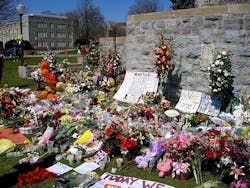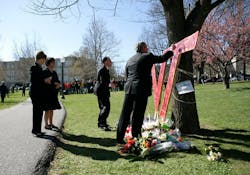Recently, the TAL Global Insider Newsletter took a closer look at a mass shooting that occurred over 15 years ago. It happened in April 2007, at Virginia Tech University.
The shooter randomly murdered 32 people for no specific reason - as is invariably the case.
After the shooting, some researchers speculated that the motive was misanthropy, a general dislike of people, or retaliation due to bullying. Because the shooter was Asian, this may have been true, but nothing conclusive has ever surfaced.
What did surface, however, was how unprepared school administrators, and then Virginia Governor Tim Kaine and his chief of staff, Bill Leighty, were to understand the situation. No one could understand all the dynamics of the situation, why it happened, and, even more important, how such an incident could be prevented from occurring again.
“There was an abundance of evidence in his particular case that a threat was possible, but no formal mechanism in place for someone [student or staff] to report it or determine whether the threat was real or not,” said Leighty.Abundance of Evidence
As to the “abundance of evidence,” investigators later reported ample reasons the shooter posed a danger to himself and those at the school. The shooter, they reported, exhibited a “troubling pattern of behavior,” including stalking teachers and students, property destruction, intimidation of professors, and making statements that he wanted to commit suicide.
Nevertheless, he remained on campus.
Incidents like this are more common than we realize, even today.
When schools, universities, businesses, or healthcare facilities experience such a violent incident, it is often not until after the incident that they grasp how few — if any — mechanisms are in place to address such a situation and how few — if any — mechanisms are in place to prevent, or at least lessen, the chances of it happening again.
Eventually in the Virginia Tech incident, university administrators turned to one of their staff to prepare what is called a workplace violence threat assessment, which included a Threat Assessment Team. According to the University, the mission of the Team is to:
Determine if an individual poses, or may reasonably pose, a threat of violence to self, others, or the Virginia Tech community and intervene to avert the threat and maintain the safety of the situation. The team responds to behaviors exhibited by students, employees, visitors, and non-affiliated persons… in an attempt to prevent violence.
Their program was copied by other universities nationwide and appeared to work well for many years.
However, in 2022, the “umbrella of safety” it created was pierced. That year, a shooter killed three of his fellow football players and wounded two others.
In this case, the shooter did not come out of the dark. He was on the Threat Assessment Team’s watch list. In fact, before the shooting, the team met with the shooter’s roommate and reported their concerns about the shooter. The roommate denied there were problems, and the case was closed.
“We cannot walk away like this again,” says Oscar Villanueva, a threat assessment expert and COO of TAL Global. “We must take all necessary steps to prevent such incidents — too many people are getting killed.”
A mass shooting is an incident in which four or more victims are shot or killed. Villanueva points out that in 2007, the year of the Virginia Tech shooting, it was estimated that there were 14 mass shootings. As of May 2023, there have been 184 mass shootings.
Underreported Impacts
Before we present ways to prevent, mitigate, or manage such incidents, we should know there are some lesser-known but just as tragic impacts of these events. “Typically, the event happens, we learn about the shooter, those killed, and then we — and the media — move on,” says Villanueva. “But there are far more devastations, most of which are never reported.”
For instance:
• Shootings may cause students and their families to move away. Because school districts are typically paid based on enrollment, this can mean less state and federal funding for already financially strapped school districts.
• The cost of gun violence extends beyond the death toll of a mass shooting. Some students, teachers, and staff are traumatized for months, even years, after such events. Some teachers leave the profession altogether, which is one reason for the shortage of teachers in this country.
• Boys appear to be most impacted by school violence because they are most often the subject of mass shootings. This negatively impacts their current and future education and their later careers in life.
“Something else that is happening, which is becoming a true cause for concern, is that many Americans are becoming desensitized to these events,” adds Villanueva. “Violence using guns is evolving into an [unfortunate, but] acceptable way of handling disagreements, grievances, and emotional turmoil.”Prevention, Mitigation, Management
When it comes to workplace violence, or in this case, school violence, what is necessary to help prevent, mitigate and manage such incidents is a professionally conducted workplace/school space threat assessment.
“The power of a [workplace violence] threat assessment is that they put all the pieces of the puzzle together to help prevent, mitigate or manage such incidents,” says Villanueva.
Threat assessments are conducted before the incident occurs in an effort to prevent it or prepare for it to mitigate or manage. This is not something that is done after the fact. What you write about here is a post-incident investigation, including pre-litigation investigations (a topic we should cover at some point), and not a threat assessment. I revised and explained this in your other document on this subject. Review and use the information I already provided. If you need more let me know.
If the shooting has recently occurred, this involves:
• Determining how it happened.
• Examining what was on the shooter’s mind when it happened.
• Interviewing the shooter’s family, the victims, witnesses, police, and mental healthcare experts.
• Looking into the perpetrator’s mental health issues.
• Checking social media; many shooters use social media to discuss their plans of violence ahead of time.
“We cannot allow any of us to become desensitized to mass shootings. Depending on the source, there have been 14,000 people killed due to shootings and mass shootings so far this year. This must stop,” says Villanueva, who points out that about half of these deaths were suicides. However, an analysis by the National Institute of Justice found that suicidal intentions are a “strong predictor” that someone might turn their personal crisis into a mass shooting.
There is no easy solution as to how schools, universities, and facility managers can protect their people and property. But according to Villanueva, conducting a workplace/school space threat assessment will be a big step forward in accomplishing this.





